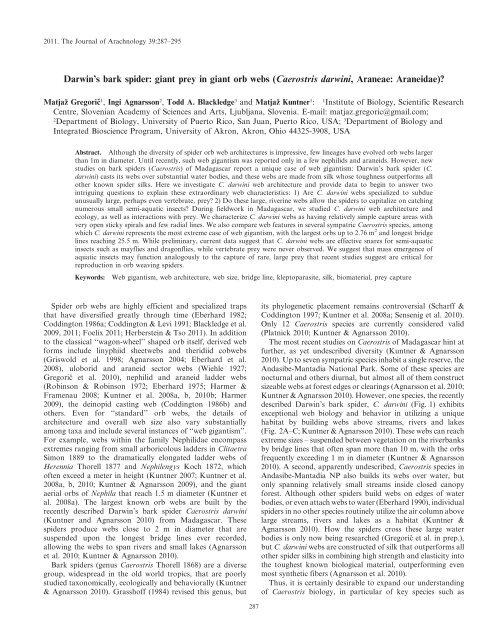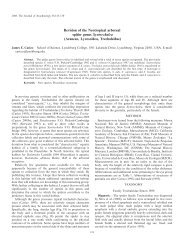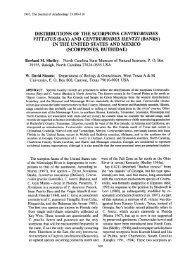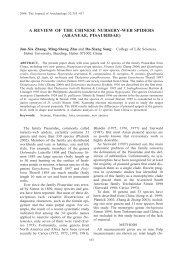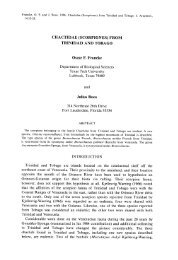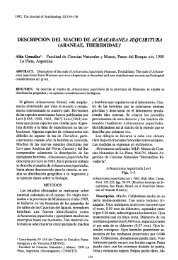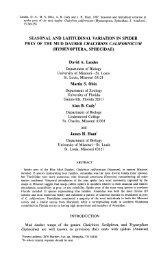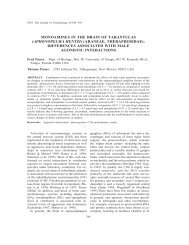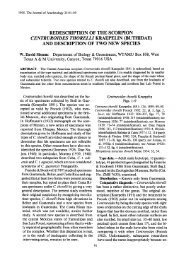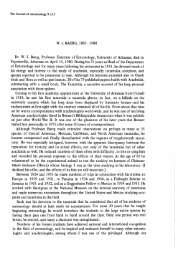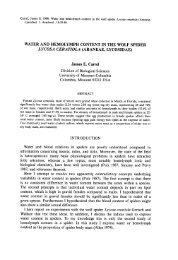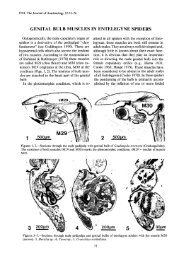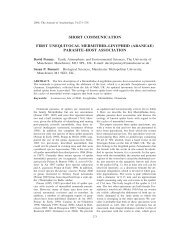Darwin's bark spider: giant prey in giant orb webs (Caerostris ...
Darwin's bark spider: giant prey in giant orb webs (Caerostris ...
Darwin's bark spider: giant prey in giant orb webs (Caerostris ...
You also want an ePaper? Increase the reach of your titles
YUMPU automatically turns print PDFs into web optimized ePapers that Google loves.
2011. The Journal of Arachnology 39:287–295<br />
Darw<strong>in</strong>’s <strong>bark</strong> <strong>spider</strong>: <strong>giant</strong> <strong>prey</strong> <strong>in</strong> <strong>giant</strong> <strong>orb</strong> <strong>webs</strong> (<strong>Caerostris</strong> darw<strong>in</strong>i, Araneae: Araneidae)?<br />
Matjazˇ Gregorič 1 , Ingi Agnarsson 2 , Todd A. Blackledge 3 and Matjazˇ Kuntner 1 : 1 Institute of Biology, Scientific Research<br />
Centre, Slovenian Academy of Sciences and Arts, Ljubljana, Slovenia. E-mail: matjaz.gregoric@gmail.com;<br />
2 Department of Biology, University of Puerto Rico, San Juan, Puerto Rico, USA; 3 Department of Biology and<br />
Integrated Bioscience Program, University of Akron, Akron, Ohio 44325-3908, USA<br />
Abstract. Although the diversity of <strong>spider</strong> <strong>orb</strong> web architectures is impressive, few l<strong>in</strong>eages have evolved <strong>orb</strong> <strong>webs</strong> larger<br />
than 1m <strong>in</strong> diameter. Until recently, such web gigantism was reported only <strong>in</strong> a few nephilids and araneids. However, new<br />
studies on <strong>bark</strong> <strong>spider</strong>s (<strong>Caerostris</strong>) of Madagascar report a unique case of web gigantism: Darw<strong>in</strong>’s <strong>bark</strong> <strong>spider</strong> (C.<br />
darw<strong>in</strong>i) casts its <strong>webs</strong> over substantial water bodies, and these <strong>webs</strong> are made from silk whose toughness outperforms all<br />
other known <strong>spider</strong> silks. Here we <strong>in</strong>vestigate C. darw<strong>in</strong>i web architecture and provide data to beg<strong>in</strong> to answer two<br />
<strong>in</strong>trigu<strong>in</strong>g questions to expla<strong>in</strong> these extraord<strong>in</strong>ary web characteristics: 1) Are C. darw<strong>in</strong>i <strong>webs</strong> specialized to subdue<br />
unusually large, perhaps even vertebrate, <strong>prey</strong>? 2) Do these large, river<strong>in</strong>e <strong>webs</strong> allow the <strong>spider</strong>s to capitalize on catch<strong>in</strong>g<br />
numerous small semi-aquatic <strong>in</strong>sects? Dur<strong>in</strong>g fieldwork <strong>in</strong> Madagascar, we studied C. darw<strong>in</strong>i web architecture and<br />
ecology, as well as <strong>in</strong>teractions with <strong>prey</strong>. We characterize C. darw<strong>in</strong>i <strong>webs</strong> as hav<strong>in</strong>g relatively simple capture areas with<br />
very open sticky spirals and few radial l<strong>in</strong>es. We also compare web features <strong>in</strong> several sympatric <strong>Caerostris</strong> species, among<br />
which C. darw<strong>in</strong>i represents the most extreme case of web gigantism, with the largest <strong>orb</strong>s up to 2.76 m 2 and longest bridge<br />
l<strong>in</strong>es reach<strong>in</strong>g 25.5 m. While prelim<strong>in</strong>ary, current data suggest that C. darw<strong>in</strong>i <strong>webs</strong> are effective snares for semi-aquatic<br />
<strong>in</strong>sects such as mayflies and dragonflies, while vertebrate <strong>prey</strong> were never observed. We suggest that mass emergence of<br />
aquatic <strong>in</strong>sects may function analogously to the capture of rare, large <strong>prey</strong> that recent studies suggest are critical for<br />
reproduction <strong>in</strong> <strong>orb</strong> weav<strong>in</strong>g <strong>spider</strong>s.<br />
Keywords: Web gigantism, web architecture, web size, bridge l<strong>in</strong>e, kleptoparasite, silk, biomaterial, <strong>prey</strong> capture<br />
Spider <strong>orb</strong> <strong>webs</strong> are highly efficient and specialized traps<br />
that have diversified greatly through time (Eberhard 1982;<br />
Codd<strong>in</strong>gton 1986a; Codd<strong>in</strong>gton & Levi 1991; Blackledge et al.<br />
2009, 2011; Foelix 2011; Herberste<strong>in</strong> & Tso 2011). In addition<br />
to the classical ‘‘wagon-wheel’’ shaped <strong>orb</strong> itself, derived web<br />
forms <strong>in</strong>clude l<strong>in</strong>yphiid sheet<strong>webs</strong> and theridiid cob<strong>webs</strong><br />
(Griswold et al. 1998; Agnarsson 2004; Eberhard et al.<br />
2008), uloborid and araneid sector <strong>webs</strong> (Wiehle 1927;<br />
Gregorič et al. 2010), nephilid and araneid ladder <strong>webs</strong><br />
(Rob<strong>in</strong>son & Rob<strong>in</strong>son 1972; Eberhard 1975; Harmer &<br />
Framenau 2008; Kuntner et al. 2008a, b, 2010b; Harmer<br />
2009), the de<strong>in</strong>opid cast<strong>in</strong>g web (Codd<strong>in</strong>gton 1986b) and<br />
others. Even for ‘‘standard’’ <strong>orb</strong> <strong>webs</strong>, the details of<br />
architecture and overall web size also vary substantially<br />
among taxa and <strong>in</strong>clude several <strong>in</strong>stances of ‘‘web gigantism’’.<br />
For example, <strong>webs</strong> with<strong>in</strong> the family Nephilidae encompass<br />
extremes rang<strong>in</strong>g from small arboricolous ladders <strong>in</strong> Clitaetra<br />
Simon 1889 to the dramatically elongated ladder <strong>webs</strong> of<br />
Herennia Thorell 1877 and Nephilengys Koch 1872, which<br />
often exceed a meter <strong>in</strong> height (Kuntner 2007; Kuntner et al.<br />
2008a, b, 2010; Kuntner & Agnarsson 2009), and the <strong>giant</strong><br />
aerial <strong>orb</strong>s of Nephila that reach 1.5 m diameter (Kuntner et<br />
al. 2008a). The largest known <strong>orb</strong> <strong>webs</strong> are built by the<br />
recently described Darw<strong>in</strong>’s <strong>bark</strong> <strong>spider</strong> <strong>Caerostris</strong> darw<strong>in</strong>i<br />
(Kuntner and Agnarsson 2010) from Madagascar. These<br />
<strong>spider</strong>s produce <strong>webs</strong> close to 2 m <strong>in</strong> diameter that are<br />
suspended upon the longest bridge l<strong>in</strong>es ever recorded,<br />
allow<strong>in</strong>g the <strong>webs</strong> to span rivers and small lakes (Agnarsson<br />
et al. 2010; Kuntner & Agnarsson 2010).<br />
Bark <strong>spider</strong>s (genus <strong>Caerostris</strong> Thorell 1868) are a diverse<br />
group, widespread <strong>in</strong> the old world tropics, that are poorly<br />
studied taxonomically, ecologically and behaviorally (Kuntner<br />
& Agnarsson 2010). Grasshoff (1984) revised this genus, but<br />
287<br />
its phylogenetic placement rema<strong>in</strong>s controversial (Scharff &<br />
Codd<strong>in</strong>gton 1997; Kuntner et al. 2008a; Sensenig et al. 2010).<br />
Only 12 <strong>Caerostris</strong> species are currently considered valid<br />
(Platnick 2010; Kuntner & Agnarsson 2010).<br />
The most recent studies on <strong>Caerostris</strong> of Madagascar h<strong>in</strong>t at<br />
further, as yet undescribed diversity (Kuntner & Agnarsson<br />
2010). Up to seven sympatric species <strong>in</strong>habit a s<strong>in</strong>gle reserve, the<br />
Andasibe-Mantadia National Park. Some of these species are<br />
nocturnal and others diurnal, but almost all of them construct<br />
sizeable <strong>webs</strong> at forest edges or clear<strong>in</strong>gs (Agnarsson et al. 2010;<br />
Kuntner & Agnarsson 2010). However, one species, the recently<br />
described Darw<strong>in</strong>’s <strong>bark</strong> <strong>spider</strong>, C. darw<strong>in</strong>i (Fig. 1) exhibits<br />
exceptional web biology and behavior <strong>in</strong> utiliz<strong>in</strong>g a unique<br />
habitat by build<strong>in</strong>g <strong>webs</strong> above streams, rivers and lakes<br />
(Fig. 2A–C; Kuntner & Agnarsson 2010). These <strong>webs</strong> can reach<br />
extreme sizes – suspended between vegetation on the riverbanks<br />
by bridge l<strong>in</strong>es that often span more than 10 m, with the <strong>orb</strong>s<br />
frequently exceed<strong>in</strong>g 1 m <strong>in</strong> diameter (Kuntner & Agnarsson<br />
2010). A second, apparently undescribed, <strong>Caerostris</strong> species <strong>in</strong><br />
Andasibe-Mantadia NP also builds its <strong>webs</strong> over water, but<br />
only spann<strong>in</strong>g relatively small streams <strong>in</strong>side closed canopy<br />
forest. Although other <strong>spider</strong>s build <strong>webs</strong> on edges of water<br />
bodies, or even attach <strong>webs</strong> to water (Eberhard 1990), <strong>in</strong>dividual<br />
<strong>spider</strong>s <strong>in</strong> no other species rout<strong>in</strong>ely utilize the air column above<br />
large streams, rivers and lakes as a habitat (Kuntner &<br />
Agnarsson 2010). How the <strong>spider</strong>s cross these large water<br />
bodies is only now be<strong>in</strong>g researched (Gregorič et al. <strong>in</strong> prep.),<br />
but C. darw<strong>in</strong>i <strong>webs</strong> are constructed of silk that outperforms all<br />
other <strong>spider</strong> silks <strong>in</strong> comb<strong>in</strong><strong>in</strong>g high strength and elasticity <strong>in</strong>to<br />
the toughest known biological material, outperform<strong>in</strong>g even<br />
most synthetic fibers (Agnarsson et al. 2010).<br />
Thus, it is certa<strong>in</strong>ly desirable to expand our understand<strong>in</strong>g<br />
of <strong>Caerostris</strong> biology, <strong>in</strong> particular of key species such as
288 THE JOURNAL OF ARACHNOLOGY<br />
Figure 1.—<strong>Caerostris</strong> darw<strong>in</strong>i <strong>in</strong> Andasibe-Mantadia NP: A. male with female <strong>in</strong> vegetation; B–D, females with typical color (C) and two less<br />
common color forms (B, D).<br />
C. darw<strong>in</strong>i. In this paper, we broaden knowledge of C. darw<strong>in</strong>i<br />
natural history by characteriz<strong>in</strong>g their <strong>webs</strong>, <strong>in</strong>clud<strong>in</strong>g a<br />
comparison with three congeners. We also beg<strong>in</strong> to test<br />
whether or not their <strong>giant</strong> river<strong>in</strong>e <strong>webs</strong> are specialized for<br />
captur<strong>in</strong>g exceptional <strong>prey</strong>. The comb<strong>in</strong>ation of web gigantism<br />
and the high material toughness of C. darw<strong>in</strong>i silk, as well as<br />
the <strong>webs</strong>’ location across rivers that could act as flyways,<br />
suggests that these <strong>webs</strong> could be specialized <strong>in</strong> part for<br />
capture of small fly<strong>in</strong>g vertebrates – birds or bats (Agnarsson<br />
et al. 2010; Kuntner & Agnarsson 2010). Both birds and bats<br />
are occasionally captured <strong>in</strong> the <strong>webs</strong> of several species of <strong>orb</strong><br />
<strong>spider</strong>s (Levi 1970; Graham 1997; Peloso & de Sousa 2007;
GREGORIČ ET AL.—CAEROSTRIS DARWINI WEBS AND PREY 289<br />
Figure 2.—<strong>Caerostris</strong> darw<strong>in</strong>i habitat and <strong>prey</strong>: <strong>webs</strong> suspended above water <strong>in</strong> Ranomafana NP (C) and Andasibe-Mantadia NP with whole<br />
<strong>orb</strong>s (A) and only bridge threads (B) visible; C. darw<strong>in</strong>i female with a robust (D) and a rudimentary (E) stabilimentum <strong>in</strong> web.<br />
Sakai 2007; Timm & Losilla 2007). Sensenig et al. (2010) used<br />
web architecture and silk biomechanics to estimate that C.<br />
darw<strong>in</strong>i <strong>webs</strong> could resist up to 62 mJ/cm 2 of <strong>prey</strong> energy<br />
without break<strong>in</strong>g dur<strong>in</strong>g impact, which approaches the flight<br />
energy of some birds and bats, the smallest of which are less<br />
than 2 g body mass and fly at speeds less than 5 m/s.<br />
Alternatively, or additionally, C. darw<strong>in</strong>i <strong>webs</strong> could present<br />
large surface areas for the simultaneous capture of numerous<br />
aquatic <strong>in</strong>sects, especially dur<strong>in</strong>g mass emergences.<br />
METHODS<br />
Field site.—We studied C. darw<strong>in</strong>i and three other syntopic<br />
<strong>Caerostris</strong> species (labeled as ‘‘sp. 1’’, ‘‘sp. 2’’ and ‘‘sp. 3’’) <strong>in</strong><br />
Andasibe-Mantadia National Park (between 18.94760uS,<br />
48.41972uE and 18.79841uS, 48.42631uE at, 960 m elev.),<br />
Toamas<strong>in</strong>a Prov<strong>in</strong>ce, eastern Madagascar, on 24 February<br />
2010–4 April 2010. Voucher specimens are deposited <strong>in</strong> the<br />
collections of the National Museum of Natural History,<br />
Smithsonian Institution, Wash<strong>in</strong>gton, DC.<br />
Behavioral record<strong>in</strong>g.—We video recorded and photographed<br />
<strong>prey</strong> capture behavior and web architecture us<strong>in</strong>g<br />
camcorders (Sony DCR-SR87 HDD) and SLR cameras<br />
(Canon EOS 5D Mark II and EOS 7D).<br />
Web characteristics.—To measure how long C. darw<strong>in</strong>i <strong>webs</strong><br />
persisted, we monitored 20 <strong>webs</strong> of mature females for three<br />
days and documented web build<strong>in</strong>g time. We also quantified<br />
web parameters for an additional 26 mature females’ <strong>webs</strong><br />
illustrated <strong>in</strong> Fig. 3a–c as well as length of bridge l<strong>in</strong>e (Fig. 2B,<br />
C), number of radii, number of sticky spirals (SS) along the<br />
vertical axis, number of kleptoparasitic <strong>spider</strong>s associated with<br />
the web, stabilimentum (def<strong>in</strong>ed as absent (0), rudimentary (1)<br />
or robust (2) (Fig. 2D, E)), habitat (def<strong>in</strong>ed as above water (0)<br />
or not above water (1)), canopy (def<strong>in</strong>ed as open (0) or closed<br />
(1) if estimated that more than 50% of the canopy was covered<br />
by tree crowns). Most of the above parameters have been used<br />
previously <strong>in</strong> the literature (e.g. Risch 1977; Opell 1999;<br />
Herberste<strong>in</strong> & Tso 2000; Blackledge & Gillespie 2002; Kuntner<br />
et al. 2010; Kuntner & Agnarsson 2009; Gregorič et al. 2010;<br />
Nakata & Zschokke 2010).<br />
To quantify web shapes, we then calculated <strong>in</strong>dices<br />
follow<strong>in</strong>g Peters (1937), Blackledge & Gillespie (2002), and<br />
Kuntner et al. (2008b): Web capture area (CA) was def<strong>in</strong>ed by<br />
the formula:<br />
CA~ ða=2Þ ðb=2Þ p<br />
where a and b were the horizontal and vertical diameters,<br />
respectively, of the capture area. Mesh width was def<strong>in</strong>ed as<br />
the number of rows of SS per centimeter of web height.<br />
We calculated a ladder <strong>in</strong>dex (LI) or vertical eccentricity of<br />
capture area as:
290 THE JOURNAL OF ARACHNOLOGY<br />
Figure 3.—Web of female <strong>Caerostris</strong> darw<strong>in</strong>i illustrat<strong>in</strong>g <strong>in</strong>vestigated<br />
parameters: web width (a), web height (b) and top sticky spiral<br />
to hub distance (c).<br />
LI~b=a<br />
We also determ<strong>in</strong>ed vertical web asymmetry through hub<br />
displacement <strong>in</strong>dex (HD) as:<br />
HD~ ðb{cÞ=b where c was the distance from the center of the hub to the<br />
bottom of the capture area.<br />
For an additional comparison of web size, we measured web<br />
width, height, top sticky spiral to hub distance, and bridge<br />
length <strong>in</strong> <strong>Caerostris</strong> ‘‘sp. 1’’ (n 5 16), ‘‘sp. 2’’ (n 5 22) and ‘‘sp.<br />
3’’ (n 5 5). We then compared our data with published data<br />
for web sizes of other <strong>orb</strong> weav<strong>in</strong>g <strong>spider</strong>s, limit<strong>in</strong>g ourselves<br />
to <strong>webs</strong> of at least 0.1 m 2 (Table 1).<br />
Prey capture.—To document <strong>prey</strong> capture, we recorded<br />
every wrapped or fed upon <strong>prey</strong> item <strong>in</strong> C. darw<strong>in</strong>i <strong>webs</strong>.<br />
Additionally, we video recorded four <strong>spider</strong>s dur<strong>in</strong>g the<br />
daytime for four days each, for a total of 113 h. Because the<br />
video resolution precluded exact determ<strong>in</strong>ation of <strong>prey</strong> taxa,<br />
we grouped <strong>prey</strong> items <strong>in</strong>to three size categories: small<br />
(, 1 cm), medium (1–2.5 cm) and large (. 3 cm).<br />
Based upon an analysis of web architecture and silk<br />
biomechanics, Sensenig et al. (2010) estimated that C. darw<strong>in</strong>i<br />
<strong>webs</strong> could stop higher energy fly<strong>in</strong>g <strong>prey</strong> than a phylogenetically<br />
diverse sampl<strong>in</strong>g of 16 other genera of <strong>orb</strong> <strong>spider</strong>s,<br />
<strong>in</strong>clud<strong>in</strong>g other large <strong>orb</strong>-weavers such as Nephila and<br />
Argiope. However, their estimate is a theoretical measure of<br />
maximum performance, which may not be atta<strong>in</strong>ed by actual<br />
<strong>webs</strong>, and they also did not measure how effectively the <strong>webs</strong><br />
could reta<strong>in</strong> <strong>prey</strong>. To better determ<strong>in</strong>e the maximum <strong>prey</strong> size<br />
that C. darw<strong>in</strong>i <strong>webs</strong> can stop and reta<strong>in</strong>, and to document the<br />
<strong>spider</strong>s’ attack behavior, we <strong>in</strong>troduced 34 medium and large<br />
<strong>prey</strong> items, each <strong>in</strong>to a different web. Prey <strong>in</strong>cluded five<br />
grasshoppers (2 cm), one large grasshopper (5 cm), one mantis<br />
(10 cm), two small frogs (2 cm), two moths (10 cm), two<br />
beetles (7 cm), 13 small dragonflies of different species (4–<br />
7 cm), and eight large (10 cm) dragonflies of one species. Prey<br />
were tossed <strong>in</strong>to the capture areas of <strong>webs</strong> from a distance of<br />
, 0.5m, more or less with the same speed and more or less<br />
perpendicular to the web plane. Although the <strong>in</strong>itial impact of<br />
<strong>prey</strong> with the web us<strong>in</strong>g this technique did not perfectly mimic<br />
natural <strong>in</strong>terceptions and we could not control for how many<br />
threads each <strong>prey</strong> contacted, our method should still provide a<br />
reasonable <strong>in</strong>dex of the ability of C. darw<strong>in</strong>i <strong>webs</strong> to stop and<br />
reta<strong>in</strong> several different types of potential <strong>prey</strong>.<br />
Statistical analysis.—We checked all data for normality<br />
us<strong>in</strong>g Kolmogorov-Smirnov tests. Because the distribution of<br />
data was not normal for bridge length and web area, we report<br />
medians (m 1/2) 6 <strong>in</strong>terquartile ranges for these parameters,<br />
while we report mean values (A) 6 standard deviations for<br />
other data. We tested <strong>in</strong>terspecific differences <strong>in</strong> web measures<br />
us<strong>in</strong>g the Kruskal-Wallis test and Mann-Whitney U-tests. We<br />
set the significance level to 0.008 or lower (Bonferroni<br />
correction). We performed all analyses <strong>in</strong> PASW 18 for<br />
W<strong>in</strong>dows (Field 2005).<br />
RESULTS<br />
Web characteristics.—<strong>Caerostris</strong> darw<strong>in</strong>i <strong>orb</strong>s ranged <strong>in</strong> size<br />
from 0.21 m 2 to 2.76 m 2 (m1/2 5 0.61 6 0.52 m 2 ). Capture area<br />
did not significantly differ from those of <strong>Caerostris</strong> sp. 1 and<br />
<strong>Caerostris</strong> sp. 2 (m1/2 5 0.48 6 0.21 m 2 and m1/2 5 0.5 6<br />
0.39 m 2 , respectively), whereas <strong>Caerostris</strong> sp. 3 had a<br />
significantly smaller capture area (m1/2 5 0.16 6 0.1 m 2 ,<br />
Fig. 4). Bridge l<strong>in</strong>es of C. darw<strong>in</strong>i <strong>orb</strong>s were 0.95–25.5 m (m1/2 5 3.5 6 2.6 m), significantly longer than those of other<br />
<strong>Caerostris</strong> species (m1/2 5 1.7 6 1.1 m <strong>in</strong> sp. 1; 1.8 6 1.2 m <strong>in</strong><br />
sp. 2 and 1.4 6 0.67 m <strong>in</strong> sp. 3; Fig. 4). The <strong>webs</strong> of C. darw<strong>in</strong>i<br />
conta<strong>in</strong>ed 15–30 radii (A 5 23.5 6 4), no split radii, 40–155<br />
vertical SS (A 5 97 6 25) and mesh widths of 0.51–1.7 SS/cm<br />
(A 5 1.04 6 0.33). All <strong>webs</strong> lacked secondary radii (Kuntner<br />
et al. 2008a), and only two (8%) <strong>webs</strong> had stabilimenta (both<br />
‘‘rudimentary’’). The <strong>webs</strong> were almost symmetric with the<br />
ladder <strong>in</strong>dex of 0.78–1.49 (A 5 1.19 6 0.18) and hub<br />
displacement of 0.47–0.69 (A 5 0.59 6 0.05). Most (63%)<br />
<strong>webs</strong> did not conta<strong>in</strong> kleptoparasitic <strong>spider</strong>s. Four (21%) <strong>webs</strong><br />
conta<strong>in</strong>ed one or two kleptoparasites (all Argyrod<strong>in</strong>ae),<br />
whereas only three (16%) <strong>webs</strong> conta<strong>in</strong>ed more.<br />
All <strong>webs</strong> were suspended above or at the edges of water<br />
bodies and always under open canopy (Fig. 2A–C). The <strong>webs</strong><br />
never had retreats, and the <strong>spider</strong>s sat at the hub dur<strong>in</strong>g all<br />
weather conditions (not remov<strong>in</strong>g SS dur<strong>in</strong>g ra<strong>in</strong>), day and<br />
night. Our monitor<strong>in</strong>g of 20 <strong>webs</strong> over 3 days revealed that the<br />
<strong>webs</strong> were not long last<strong>in</strong>g. In two of these 20 <strong>webs</strong>, the host<br />
<strong>spider</strong> was absent for the whole time, and two more <strong>spider</strong>s<br />
disappeared dur<strong>in</strong>g observation. The other 15 <strong>spider</strong>s renewed<br />
their <strong>webs</strong> two to four times <strong>in</strong> 3 days. Web renewal usually<br />
(74%) took place between 1600 and 1800 h. However,<br />
throughout our fieldwork we observed numerous <strong>webs</strong> be<strong>in</strong>g<br />
constructed at the same location, suspended on bridge l<strong>in</strong>es<br />
that were clearly reta<strong>in</strong>ed for several days. We thus estimated<br />
that bridge l<strong>in</strong>es can be ma<strong>in</strong>ta<strong>in</strong>ed for at least 5 wk. We never<br />
observed web destruction by fly<strong>in</strong>g vertebrates or large <strong>in</strong>sects,<br />
but regularly observed dragonflies avoid<strong>in</strong>g the <strong>webs</strong> and even<br />
perch<strong>in</strong>g on bridge l<strong>in</strong>es.
GREGORIČ ET AL.—CAEROSTRIS DARWINI WEBS AND PREY 291<br />
Table 1.—Comparison of web size (if . 0.1 m 2 ) among <strong>orb</strong> web <strong>spider</strong>s, measured for adult and penultimate female <strong>webs</strong>.<br />
Species Web area (m 2 ) Max. web area (m 2 ) Author<br />
Metell<strong>in</strong>a merianae (Scopoli 1763) 0.28 Wiehle 1927<br />
Argiope kather<strong>in</strong>a Levi 1983 (n 5 24) 0.13 0.22 Rao pers. comm.<br />
Herennia etruscilla Kuntner 2005 (n 5 2) 0.13 0.14 Kuntner et al. 2010b<br />
Talthybia depressa Thorell 1898 (n 5 1) 0.21 0.21 own data<br />
Eriovixia laglaizei (Simon 1877) (n 5 1) 0.32 0.32 own data<br />
Nephilengys dodo Kuntner & Agnarsson 2011 (n 5 2) 0.44 0.56 own data<br />
<strong>Caerostris</strong> sumatrana Strand 1915 (n 5 1) 0.62 0.62 own data<br />
Herennia multipuncta (Doleschall 1859) (n 5 6) 0.11 6 0.2 0.29 Kuntner et al. 2010b<br />
Nephila <strong>in</strong>aurata (Walckenaer 1841) (n 5 23) 0.12 6 0.28 1.15 own data<br />
Argiope radon Levi 1983 (n 5 103) 0.122 6 0.055 0.49 Rao et al. 2009, pers. comm.<br />
Argiope argentata (Fabricius 1775) (n 5 762) 0.13 6 0.045 Nentwig 1985<br />
Araneus angulatus Clerck 1757 0.13–0.31 0.31 Wiehle 1929<br />
Araneus circe (Audou<strong>in</strong> 1826) 0.13–0.28 0.28 Wiehle 1928, 1931<br />
Nephila clavipes (L<strong>in</strong>naeus 1767) (n 5 32) 0.15 6 0.07 0.35 own data<br />
<strong>Caerostris</strong> sp. 3 (n 5 5) 0.16 6 0.1 0.35 this study<br />
Nephilengys b<strong>orb</strong>onica (V<strong>in</strong>son 1863) (n 5 4) 0.19 6 0.09 0.23 own data<br />
Nephila ardentipes Butler 1876 (n 5 24) 0.19 6 0.18 0.65 own data<br />
Nephilengys malabarensis (Walckenaer 1841) (n 5 7) 0.23 6 0.16 0.41 Kuntner et al. 2010b<br />
Eriophora sp. (n 5 20) 0.24 6 0.18 0.69 own data<br />
Nephila pilipes (Fabricius 1793) (n 5 30) 0.28 6 0.15 0.63 Kuntner et al. 2010a, own data<br />
<strong>Caerostris</strong> darw<strong>in</strong>i Kuntner & Agnarsson 2010 (n 5 16) 0.28 6 0.47 1.07 Kuntner & Agnarsson 2010<br />
Argiope keyserl<strong>in</strong>gi Karsch 1878 (n 5 273) 0.3 6 0.14 Blamires et al. 2007<br />
Nephilengys livida (V<strong>in</strong>son 1863) (n 5 29) 0.33 6 0.23 0.77 own data<br />
Eriophora fulig<strong>in</strong>ea (C.L. Koch 1838) (n 5 349) 0.36 6 0.11 Nentwig 1985<br />
Nephila clavipes (L<strong>in</strong>naeus 1767) (n 5 1072) 0.36 6 0.11 Nentwig 1985<br />
<strong>Caerostris</strong> sp. 1 (n 5 16) 0.48 6 0.21 0.86 this study<br />
<strong>Caerostris</strong> sp. 2 (n 5 22) 0.5 6 0.39 1.1 this study<br />
<strong>Caerostris</strong> darw<strong>in</strong>i Kuntner & Agnarsson 2010 (n 5 26) 0.61 6 0.52 2.76 this study<br />
Prey capture.—We haphazardly encountered 25 <strong>prey</strong> items<br />
dur<strong>in</strong>g web surveys: two (8%) honey bees, three small beetles<br />
(12%), one wasp (4%), one grasshopper (4%), two damselflies<br />
(8%), one fly (4%), one (4%) queen ant, one (4%) butterfly,<br />
one (4%) large unidentified <strong>prey</strong> item, and four (16%)<br />
dragonflies. The 113 hours of video material revealed the<br />
capture of 50 (79.4%) small, 12 (19%) medium, and one (1.6%)<br />
large <strong>prey</strong> item (a papilionid butterfly). Altogether, large <strong>prey</strong><br />
items constituted 6.8% of all caught <strong>prey</strong>: 20% <strong>in</strong> haphazardly<br />
encountered <strong>prey</strong> and 1.6% <strong>in</strong> video material, but this<br />
disparity is expected because active feed<strong>in</strong>g on small, quickly<br />
consumed <strong>in</strong>sects is less likely to be<strong>in</strong>g haphazardly observed.<br />
Video material also revealed one case of kleptoparasitic flies <strong>in</strong><br />
C. darw<strong>in</strong>i (<strong>Caerostris</strong> supplementary video 3 (http://www.<br />
nephilidae.com/videos/videos.htm)).<br />
Dur<strong>in</strong>g our <strong>prey</strong> presentations (<strong>Caerostris</strong> supplementary<br />
video 1, 2 (http://www.nephilidae.com/videos/videos.htm)),<br />
frogs and large <strong>in</strong>sects (i.e., large beetles and moths) were<br />
not reta<strong>in</strong>ed <strong>in</strong> <strong>webs</strong>. The <strong>webs</strong> reta<strong>in</strong>ed all five 2-cm, but not<br />
the 5 cm grasshopper. Out of the 21 dragonflies <strong>in</strong>troduced,<br />
the <strong>webs</strong> reta<strong>in</strong>ed all 13 ‘‘regular sized’’ specimens, but only<br />
four of the eight ‘‘large’’ ones.<br />
All <strong>spider</strong>s performed bite-wrap attack behavior (<strong>Caerostris</strong><br />
supplementary video 1 (http://www.nephilidae.com/videos/<br />
videos.htm); Eberhard 1982). The <strong>spider</strong>s carried all <strong>prey</strong>,<br />
except the largest dragonflies, back to the hub <strong>in</strong> their<br />
chelicerae (<strong>Caerostris</strong> supplementary video 1 (http://www.<br />
nephilidae.com/videos/videos.htm)), while the large dragonflies<br />
were lifted to the hub on a silk thread while still attached<br />
to other parts of web (<strong>Caerostris</strong> supplementary video 2<br />
(http://www.nephilidae.com/videos/videos.htm)).<br />
DISCUSSION<br />
The present study shows that <strong>Caerostris</strong> darw<strong>in</strong>i build the<br />
longest bridge l<strong>in</strong>es and largest <strong>orb</strong> <strong>webs</strong> known, with<br />
exceptional <strong>webs</strong> bridg<strong>in</strong>g water bodies more than 25 m across<br />
and capture areas reach<strong>in</strong>g 2.76 m 2 (Tables 1, 2; Fig. 4). C.<br />
darw<strong>in</strong>i <strong>webs</strong> conta<strong>in</strong> relatively sparsely spaced capture spirals<br />
and are almost symmetrical (Sensenig et al. 2010). Webs are<br />
always suspended above or next to water and their capture<br />
areas are renewed daily. In contrast, bridge l<strong>in</strong>es are<br />
ma<strong>in</strong>ta<strong>in</strong>ed and re<strong>in</strong>forced regularly, for up to five weeks.<br />
We found no evidence that these <strong>giant</strong> <strong>webs</strong> are an adaptation<br />
for captur<strong>in</strong>g fly<strong>in</strong>g vertebrates, such as birds or bats. First, no<br />
such large <strong>prey</strong> items were caught <strong>in</strong> the web, although the<br />
sample size <strong>in</strong> this study is small enough that such rare events<br />
could have been missed (Blackledge 2011). Second, numerous<br />
visually acute fly<strong>in</strong>g <strong>in</strong>sects, such as dragonflies, were seen<br />
avoid<strong>in</strong>g the <strong>webs</strong> throughout the field study. While dragonflies<br />
are exceptionally maneuverable fliers (Alexander 1984,<br />
1986; Azuma et al. 1988; Thomas et al. 2004), this observation<br />
suggests that fly<strong>in</strong>g vertebrates might also perceive and avoid<br />
the <strong>webs</strong>. On the other hand, <strong>orb</strong> <strong>spider</strong>s can still capture<br />
substantial numbers of <strong>in</strong>sects <strong>in</strong> taxa that see and avoid<br />
<strong>spider</strong> <strong>webs</strong> (Craig 1994; Rao et al. 2008). Third, the relatively<br />
sparse pack<strong>in</strong>g of silk <strong>in</strong> the <strong>webs</strong>, which have significantly<br />
larger mesh widths than similarly sized <strong>orb</strong> weavers (Sensenig<br />
et al. 2010), necessarily limit their stopp<strong>in</strong>g and retention
292 THE JOURNAL OF ARACHNOLOGY<br />
Figure 4.—Web size <strong>in</strong> <strong>Caerostris</strong> darw<strong>in</strong>i and three congeneric<br />
species. A. Web capture area (m 2 ). B. Bridge thread length (m).<br />
Asterisk marks the species that significantly differ from the others.<br />
power. Instead, along with our previous study, we found that<br />
these <strong>webs</strong> subdue small to large fly<strong>in</strong>g <strong>in</strong>sects, such as<br />
mayflies (Kuntner & Agnarsson 2010) and dragonflies (this<br />
study).<br />
Web characteristics.—Although the maximal values of web<br />
size are statistical outliers (Fig. 4) <strong>in</strong> our study, we believe it<br />
likely that <strong>webs</strong> are often even larger <strong>in</strong> nature. Many C.<br />
darw<strong>in</strong>i <strong>webs</strong> are suspended far from the shores of rivers and<br />
lakes or high <strong>in</strong> the air column such that we simply could not<br />
measure them. These open, aerial microhabitats are less<br />
spatially limited, compared to the more easily accessible space<br />
directly above the water surface that we studied. Thus, C.<br />
darw<strong>in</strong>i may be capable of build<strong>in</strong>g larger <strong>webs</strong> than we<br />
measured.<br />
With the exception of their extreme size and unusual<br />
microhabitat, C. darw<strong>in</strong>i <strong>webs</strong> resemble typical araneid <strong>orb</strong>s <strong>in</strong><br />
many respects (Zschokke 2002; Kuntner et al. 2008a; Kuntner<br />
& Agnarsson 2010). They are more or less vertical, almost<br />
symmetric, have closed hubs, non-sticky spirals are removed<br />
from f<strong>in</strong>ished <strong>webs</strong>, have gradual hub-loop to sticky spiral<br />
transitions, have few radii and SS compared to other <strong>orb</strong><br />
weavers (Sensenig et al. 2010), have no split radii, lack retreats,<br />
and rarely conta<strong>in</strong> stabilimenta (Eberhard 1982). Kuntner &<br />
Agnarsson (2010) reported the hub as open or closed;<br />
however, this is <strong>in</strong>correct. We only observed the typically<br />
araneid closed hub and the complete lack of the hub bite-out<br />
behavior (Gregorič et al. <strong>in</strong> prep.). Kuntner & Agnarsson<br />
(2010) speculated that the <strong>webs</strong> last longer than typical<br />
araneid <strong>orb</strong>s, but did not have long-term observations of<br />
<strong>in</strong>dividual <strong>webs</strong> over several days. In fact, only the bridge l<strong>in</strong>es<br />
are long last<strong>in</strong>g, while the capture areas are renewed daily as <strong>in</strong><br />
most other <strong>orb</strong> weavers (Foelix 1996; Carico 1986). The web<br />
build<strong>in</strong>g behaviors of C. darw<strong>in</strong>i depart from typical araneids<br />
(Eberhard 1982; Kuntner 2008a). C. darw<strong>in</strong>i exhibit m<strong>in</strong>imal<br />
web site exploration and build <strong>webs</strong> that lack secondary frame<br />
threads. The relatively simple capture areas conta<strong>in</strong> very open<br />
sticky spirals, supported by few radii that are both s<strong>in</strong>gle and<br />
doubled <strong>in</strong> the same web. Detailed comparison of web<br />
sp<strong>in</strong>n<strong>in</strong>g behaviors will be fully summarized elsewhere<br />
(Gregorič et al. <strong>in</strong> prep.).<br />
Attack behavior.—<strong>Caerostris</strong> darw<strong>in</strong>i attacks all <strong>prey</strong> by first<br />
bit<strong>in</strong>g and then wrapp<strong>in</strong>g them. Typical araneid, tetragnathid<br />
and uloborid attack behavior is wrap-bit<strong>in</strong>g (Eberhard 1982),<br />
which probably evolved six to seven times with<strong>in</strong> <strong>orb</strong>icularian<br />
<strong>spider</strong>s (Kuntner et al. 2008a). In contrast, bite-wrapp<strong>in</strong>g is<br />
probably plesiomorphic for a larger clade of <strong>orb</strong> <strong>spider</strong>s<br />
(Kuntner et al. 2008a), and is utilized by nephilids, some<br />
araneids such as Deliochus, Phonognatha, <strong>Caerostris</strong> (Kuntner<br />
et al. 2008a) and Zygiella s.l. (Gregorič et al. 2010). <strong>Caerostris</strong><br />
darw<strong>in</strong>i uses bite-wrapp<strong>in</strong>g regardless of <strong>prey</strong> size, whereas<br />
many wrap-bit<strong>in</strong>g <strong>spider</strong>s occasionally bite-wrap <strong>in</strong> response<br />
to different taxa of <strong>prey</strong> (Rob<strong>in</strong>son & Rob<strong>in</strong>son 1974; Foelix<br />
1996). <strong>Caerostris</strong> darw<strong>in</strong>i also uses a relatively unusual<br />
behavior for transport<strong>in</strong>g subdued <strong>prey</strong> back to the hub.<br />
Instead of free<strong>in</strong>g large <strong>prey</strong> from the web and hang<strong>in</strong>g them<br />
on a short thread (Foelix 1996), C. darw<strong>in</strong>i carries even large<br />
<strong>prey</strong> back to hub <strong>in</strong> their chelicerae (<strong>Caerostris</strong> supplementary<br />
video 1 (http://www.nephilidae.com/videos/videos.htm)). Only<br />
the largest dragonflies were not carried us<strong>in</strong>g this behavior,<br />
but <strong>in</strong>stead were lifted toward the hub us<strong>in</strong>g a longer silk<br />
thread, while the <strong>prey</strong> was still attached to other parts of web.<br />
On the other hand, this observation and the fact that many<br />
<strong>orb</strong> <strong>spider</strong> species directly carry small <strong>prey</strong>, suggest that it is<br />
the large <strong>prey</strong> size threshold at which C. darw<strong>in</strong>i switches from<br />
the carry<strong>in</strong>g behavior that is unusual, rather than the behavior<br />
itself.<br />
Prey capture.—Our <strong>prey</strong> toss<strong>in</strong>g experiments found that<br />
dragonflies were the largest <strong>prey</strong> reta<strong>in</strong>ed by C. darw<strong>in</strong>i <strong>webs</strong>,<br />
with larger <strong>in</strong>sects and frogs always break<strong>in</strong>g through the<br />
<strong>webs</strong>. By far the most commonly observed <strong>prey</strong> entangled <strong>in</strong><br />
<strong>webs</strong> were small <strong>in</strong>sects, with larger (. 3 cm) <strong>prey</strong> found only<br />
at relatively low frequencies (, 7%). However, the disparity<br />
between large <strong>prey</strong> encountered haphazardly (20%) and by<br />
video material (1.6%) is expected because active feed<strong>in</strong>g on<br />
small, quickly consumed <strong>in</strong>sects is less likely to be haphazardly<br />
observed. Although we never observed exceptionally large<br />
<strong>prey</strong> <strong>in</strong> C. darw<strong>in</strong>i <strong>webs</strong>, such rare large <strong>prey</strong> may be<br />
fundamentally important for female fecundity <strong>in</strong> most <strong>orb</strong><br />
<strong>spider</strong>s, even though the rarity of their capture makes them<br />
difficult to observe <strong>in</strong> field studies (Venner & Casas 2005; see<br />
Blackledge 2011, this volume for review). Therefore, more<br />
sampl<strong>in</strong>g effort is clearly needed to thoroughly exclude the<br />
hypothesis that the unusual size and placement of C. darw<strong>in</strong>i<br />
<strong>webs</strong> facilitate the capture of exceptionally large <strong>prey</strong>.<br />
The rare, large <strong>prey</strong> hypothesis is particularly tempt<strong>in</strong>g,<br />
given the exceptional toughness of the silk <strong>in</strong> C. darw<strong>in</strong>i <strong>webs</strong><br />
(Agnarsson et al. 2010). However, <strong>orb</strong> <strong>spider</strong>s face functional<br />
tradeoffs between mak<strong>in</strong>g relatively sparse <strong>webs</strong> with large<br />
capture areas to maximize <strong>in</strong>terception of <strong>prey</strong>, versus build<strong>in</strong>g
GREGORIČ ET AL.—CAEROSTRIS DARWINI WEBS AND PREY 293<br />
Web area<br />
(m 2 )<br />
Table 2.—Web data for <strong>Caerostris</strong> darw<strong>in</strong>i females <strong>in</strong> Madagascar. SS 5 sticky spirals.<br />
Bridge length<br />
(cm) Radii no. SS no.<br />
smaller and denser <strong>webs</strong> capable of stopp<strong>in</strong>g and reta<strong>in</strong><strong>in</strong>g<br />
bigger <strong>prey</strong> (Chacon & Eberhard 1980; Eberhard 1986;<br />
Blackledge & Zevenbergen 2006; Blackledge & Eliason 2007;<br />
Sensenig et al. 2010). <strong>Caerostris</strong> darw<strong>in</strong>i web architecture is<br />
unusually open, with fewer radii and larger mesh width than<br />
other large <strong>orb</strong> <strong>webs</strong> (Sensenig et al. 2010). Thus, the <strong>webs</strong><br />
may <strong>in</strong>stead function to maximize capture surface for large<br />
numbers of small aquatic <strong>in</strong>sects, such as the mass capture of<br />
mayflies observed <strong>in</strong> C. darw<strong>in</strong>i <strong>webs</strong> by Kuntner & Agnarsson<br />
(2010). Such mass captures could even function analogously to<br />
rare, large <strong>prey</strong> <strong>in</strong> the rarity of their occurrence and their<br />
importance for forag<strong>in</strong>g success. However, no mass capture of<br />
<strong>in</strong>sects was observed <strong>in</strong> this study and might be as difficult to<br />
observe dur<strong>in</strong>g field studies as the capture of <strong>in</strong>dividual large<br />
<strong>prey</strong> (Blackledge 2011). Alternatively, the large, sparse capture<br />
areas of C. darw<strong>in</strong>i <strong>webs</strong>, comb<strong>in</strong>ed with their unusually tough<br />
silk, may represent a compromise toward subdu<strong>in</strong>g large<br />
numbers of small aquatic <strong>in</strong>sects while still ma<strong>in</strong>ta<strong>in</strong><strong>in</strong>g the<br />
ability to capture rare larger <strong>prey</strong>. Such a ‘‘multifunctional’’<br />
web would contrast with the behavior of at least one other <strong>orb</strong><br />
weaver, Parawixia, that <strong>in</strong>stead dramatically enlarges capture<br />
areas of <strong>webs</strong> only dur<strong>in</strong>g mass emergences of large, easily<br />
captured reproductive termite <strong>prey</strong> (Sandoval 1994). The<br />
evolution of the extreme silk toughness <strong>in</strong> C. darw<strong>in</strong>i may<br />
facilitate this potentially dual function of the large sparse web,<br />
mak<strong>in</strong>g it critical to better determ<strong>in</strong>e patterns of evolution for<br />
Kleptoparasite<br />
no.<br />
Mesh width<br />
(SS/cm)<br />
Ladder<br />
<strong>in</strong>dex<br />
Hub<br />
displacement<br />
0.21 130 18 40 0 0.70 1.21 0.65<br />
0.23 265 21 77 0 1.24 1.32 0.55<br />
0.25 275 20 88 0 1.47 1.15 0.63<br />
0.26 210 24 104 0 1.70 1.11 0.57<br />
0.28 330 29 89 0 1.35 1.22 0.53<br />
0.31 95 0 1.19 0.68<br />
0.41 320 23 121 0 1.57 1.13 0.60<br />
0.41 180 53 4 0.71 1.07 0.69<br />
0.41 400 0 1.07 0.57<br />
0.46 380 28 110 0 1.33 1.17 0.58<br />
0.49 164 30 82 7 1.17 0.78 0.64<br />
0.53 215 0 1.13 0.57<br />
0.61 350 83 0 0.91 1.06 0.47<br />
0.62 275 20 110 0 1.12 1.21 0.59<br />
0.64 300 29 126 6 1.22 1.30 0.58<br />
0.70 500 25 112 1 1.15 1.05 0.61<br />
0.76 450 24 103 2 1.03 1.03 0.59<br />
0.82 670 108 0 0.90 1.38 0.50<br />
0.86 350 27 91 0 0.73 1.41 0.60<br />
0.90 430 25 94 0 0.76 1.35 0.60<br />
1.15 540 23 92 1 0.70 1.19 0.66<br />
1.19 750 117 1 0.78 1.49 0.60<br />
1.21 640 83 0.51 1.71 0.58<br />
1.36 400 0 1.02 0.50<br />
2.76 550 25 155 0.79 1.08 0.58<br />
2550<br />
0.61 6 0.52 350 6 260 23.5 6 4 97 6 25 1.04 6 0.33 1.19 6 0.18 0.59 6 0.05<br />
Sp.1 mean 0.48 6 0.21 170 6 109<br />
Sp.2 mean 0.5 6 0.39 177 6 122<br />
Sp.3 mean 0.16 6 0.1 142 6 66.5<br />
both silk properties and web architecture with<strong>in</strong> the genus<br />
<strong>Caerostris</strong>.<br />
Conclusions.—<strong>Caerostris</strong> darw<strong>in</strong>i exhibits several aspects of<br />
unusual web biology that allow the <strong>spider</strong>s to sp<strong>in</strong> <strong>giant</strong> <strong>orb</strong>s<br />
suspended <strong>in</strong> the air column above bodies of water, thereby<br />
exploit<strong>in</strong>g a unique ecological niche. Prey capture data suggest<br />
that C. darw<strong>in</strong>i does not <strong>prey</strong> on fly<strong>in</strong>g vertebrates, but <strong>in</strong>stead<br />
mostly consumes medium to large fly<strong>in</strong>g <strong>in</strong>sects. We speculate<br />
that the mass emergence of aquatic <strong>in</strong>sects may function<br />
analogously for <strong>spider</strong> fitness to the capture of s<strong>in</strong>gle rare,<br />
large <strong>prey</strong> <strong>in</strong> other <strong>orb</strong> <strong>spider</strong>s. However, with the currently<br />
available data we cannot rule out alternative hypotheses for<br />
the orig<strong>in</strong> of the exceptional properties of C. darw<strong>in</strong>i silk, such<br />
as adaptation to carry the <strong>spider</strong>s’ weight on long, sagg<strong>in</strong>g<br />
bridge l<strong>in</strong>es (Rodriguez-Girones et al. 2010) or resist<strong>in</strong>g abiotic<br />
factors such as w<strong>in</strong>d and ra<strong>in</strong> (Eberhard 1990).<br />
ACKNOWLEDGMENTS<br />
This is Contribution 1 result<strong>in</strong>g from the 2010 Madagascar<br />
expedition, funded by the National Geographic Society (grant<br />
8655-09 to I. Agnarsson, M. Kuntner, and T. Blackledge).<br />
Additional fund<strong>in</strong>g came from the Slovenian Research Agency<br />
(grants P1-0236, J1-2063) and NSF (IOS-0745379). We thank<br />
the MICET crew <strong>in</strong> Antananarivo, and Sahondra Lalao<br />
Rahanitr<strong>in</strong>ia<strong>in</strong>a and Honore Rabarison for their help <strong>in</strong> the<br />
field. We also thank D<strong>in</strong>esh Rao, William Eberhard, Sean
294 THE JOURNAL OF ARACHNOLOGY<br />
Blamires and Wolfgang Nentwig for their help <strong>in</strong> gett<strong>in</strong>g web<br />
size data for other <strong>spider</strong> species.<br />
LITERATURE CITED<br />
Agnarsson, I. 2004. Morphological phylogeny of cobweb <strong>spider</strong>s and<br />
their relatives (Araneae, Araneoidea, Theridiidae). Zoological<br />
Journal of the L<strong>in</strong>nean Society 141:447–626.<br />
Agnarsson, I., M. Kuntner & T.A. Blackledge. 2010. Bioprospect<strong>in</strong>g<br />
f<strong>in</strong>ds the toughest biological material: extraord<strong>in</strong>ary silk from a<br />
<strong>giant</strong> river<strong>in</strong>e <strong>orb</strong> <strong>spider</strong>. PLoS ONE 5(9):e11234.<br />
Alexander, D.E. 1984. Unusual phase relationships between the<br />
forew<strong>in</strong>gs and h<strong>in</strong>dw<strong>in</strong>gs <strong>in</strong> fly<strong>in</strong>g dragonflies. Journal of<br />
Experimental Biology 109:379–383.<br />
Alexander, D.E. 1986. W<strong>in</strong>d tunnel studies of turns by fly<strong>in</strong>g<br />
dragonflies. Journal of Experimental Biology 122:81–98.<br />
Azuma, A. & T. Watanabe. 1988. Flight performance of a dragonfly.<br />
Journal of Experimental Biology 137:221–252.<br />
Blackledge, T.A. 2011. Prey capture <strong>in</strong> <strong>orb</strong> weav<strong>in</strong>g <strong>spider</strong>s: Are we<br />
us<strong>in</strong>g the best metric? Journal of Arachnology 39:205–210.<br />
Blackledge, T.A., M. Kuntner & I. Agnarsson. 2011. The form and<br />
function of <strong>spider</strong> <strong>orb</strong> <strong>webs</strong>: evolution from silk to ecosystems.<br />
Advances <strong>in</strong> Insect Physiology. In press.<br />
Blackledge, T.A., J. Codd<strong>in</strong>gton, N. Scharff, T. Szuts, J. Wenzel, C.<br />
Hayashi & I. Agnarsson. 2009. Reconstruct<strong>in</strong>g web evolution and<br />
<strong>spider</strong> diversification <strong>in</strong> the molecular era. Proceed<strong>in</strong>gs of the<br />
National Academy of Sciences USA 106:5229–5234.<br />
Blackledge, T.A. & C.M. Eliason. 2007. Functionally <strong>in</strong>dependent<br />
components of <strong>prey</strong> capture are architecturally constra<strong>in</strong>ed <strong>in</strong><br />
<strong>spider</strong> <strong>orb</strong> <strong>webs</strong>. Biology Letters 3:456–458.<br />
Blackledge, T.A. & R.G. Gillespie. 2002. Estimation of capture areas<br />
of <strong>spider</strong> <strong>orb</strong> <strong>webs</strong> <strong>in</strong> relation to asymmetry. Journal of<br />
Arachnology 30:70–77.<br />
Blackledge, T.A. & J.M. Zevenbergen. 2006. Mesh width <strong>in</strong>fluences<br />
<strong>prey</strong> retention <strong>in</strong> <strong>spider</strong> <strong>orb</strong> <strong>webs</strong>. Ethology 112:1194–1201.<br />
Blamires, S.J., M.B. Thompson & D.F. Hochuli. 2007. Habitat<br />
selection and web plasticity by the <strong>orb</strong> <strong>spider</strong> Argiope keyserl<strong>in</strong>gi<br />
(Argiopidae): do they compromise forag<strong>in</strong>g success for predator<br />
avoidance? Austral Ecology 32:551–563.<br />
Carico, J.E. 1986. Web removal patterns <strong>in</strong> <strong>orb</strong>-weav<strong>in</strong>g <strong>spider</strong>s.<br />
Pp. 306–318. In Spiders: Webs, Behavior, and Evolution. (W.A.<br />
Shear, ed.). Stanford University Press, Stanford, California.<br />
Chacón, P. & W.G. Eberhard. 1980. Factors affect<strong>in</strong>g numbers and<br />
k<strong>in</strong>ds of <strong>prey</strong> caught <strong>in</strong> artificial <strong>spider</strong> <strong>webs</strong>, with considerations<br />
of how <strong>orb</strong> <strong>webs</strong> trap <strong>prey</strong>. Bullet<strong>in</strong> of the British Arachnological<br />
Society 5:29–38.<br />
Codd<strong>in</strong>gton, J.A. 1986a. The monophyletic orig<strong>in</strong> of the <strong>orb</strong> web.<br />
Pp. 319–363. In Spiders: Webs, Behavior, and Evolution. (W.A.<br />
Shear, ed.). Stanford University Press, Stanford, California.<br />
Codd<strong>in</strong>gton, J.A. 1986b. Orb <strong>webs</strong> <strong>in</strong> ‘non-<strong>orb</strong> weav<strong>in</strong>g’ ogrefaced<br />
<strong>spider</strong>s (Araneae: De<strong>in</strong>opidae): a question of genealogy. Cladistics<br />
2:53–67.<br />
Codd<strong>in</strong>gton, J.A. & H.W. Levi. 1991. Systematics and evolution of<br />
<strong>spider</strong>s (Araneae). Annual Review of Ecology and Systematics<br />
22:565–592.<br />
Craig, C.L. 1994. Predator forag<strong>in</strong>g behavior <strong>in</strong> response to<br />
perception and learn<strong>in</strong>g by its <strong>prey</strong>: <strong>in</strong>teractions between <strong>orb</strong>sp<strong>in</strong>n<strong>in</strong>g<br />
<strong>spider</strong>s and st<strong>in</strong>gless bees. Behavioral Ecology and<br />
Sociobiology 35:45–52.<br />
Eberhard, W.G. 1975. Inverted ladder <strong>orb</strong> web of Scoloderus sp. and<br />
<strong>in</strong>termediate <strong>orb</strong> of Eustala sp. Araneae – Araneidae. Journal of<br />
Natural History 9:93–106.<br />
Eberhard, W.G. 1982. Behavioral characters for the higher classification<br />
of <strong>orb</strong>-weav<strong>in</strong>g <strong>spider</strong>s. Evolution 36:1067–1095.<br />
Eberhard, W.G. 1986. Effects of <strong>orb</strong>-web geometry on <strong>prey</strong><br />
<strong>in</strong>terception and retention. Pp. 70–100. In Spiders: Webs,<br />
Behavior, and Evolution. (W.A. Shear, ed.). Stanford University<br />
Press, Stanford, California.<br />
Eberhard, W.G. 1989. Effects of <strong>orb</strong> web orientation and <strong>spider</strong> size<br />
on <strong>prey</strong> retention. Bullet<strong>in</strong> of the British Arachnological Society<br />
8:45–48.<br />
Eberhard, W.G. 1990. Function and phylogeny of <strong>spider</strong> <strong>webs</strong>.<br />
Annual Review of Ecology and Systematics 21:341–372.<br />
Eberhard, W.G., I. Agnarsson & H.W. Levi. 2008. Web forms and<br />
phylogeny of theridiid <strong>spider</strong>s (Araneae: Theridiidae): chaos from<br />
order? Systematics and Biodiversity 6:415–475.<br />
Field, A. 2005. Discover<strong>in</strong>g Statistics Us<strong>in</strong>g SPSS, 2nd edition. Sage<br />
Publications, London, UK.<br />
Foelix, R.F. 1996. Biology of Spiders, 2nd edition. Oxford University<br />
Press, Oxford, UK.<br />
Foelix, R.F. 2011. Biology of Spiders, 3rd edition. Oxford University<br />
Press, Oxford, UK.<br />
Gillespie, R.G. & T. Caraco. 1987. Risk-sensitive forag<strong>in</strong>g strategies<br />
of two <strong>spider</strong> populations. Ecology 68:887–899.<br />
Graham, D.L. 1997. Spider <strong>webs</strong> and w<strong>in</strong>dows as potentially<br />
important sources of humm<strong>in</strong>gbird mortality. Journal of Field<br />
Ornithology 68:98–101.<br />
Grasshoff, M. 1984. Die Radnetzsp<strong>in</strong>nen-Gattung <strong>Caerostris</strong> (Arachnida:<br />
Araneae). Revue Zoologique Africa<strong>in</strong>e 98:725–765.<br />
Gregorič, M., R. Kostanjsˇek & M. Kuntner. 2010. Orb web features<br />
as taxonomic characters <strong>in</strong> Zygiella s.l. (Araneae, Araneidae)<br />
Journal of Arachnology 38:319–327.<br />
Griswold, C.E., J.A. Codd<strong>in</strong>gton, G. Hormiga & N. Scharff. 1998.<br />
Phylogeny of the <strong>orb</strong>-web build<strong>in</strong>g <strong>spider</strong>s (Araneae, Orbiculariae:<br />
De<strong>in</strong>opoidea, Araneoidea). Zoological Journal of the L<strong>in</strong>nean<br />
Society 123:1–99.<br />
Harmer, A.M.T. 2009. Elongated <strong>orb</strong>-<strong>webs</strong> of Australian ladder-web<br />
<strong>spider</strong>s (Araneidae: Telaprocera) and the significance of <strong>orb</strong>-web<br />
elongation. Journal of Ethology 27:453–460.<br />
Harmer, A.M.T. & V.W. Framenau. 2008. Telaprocera (Araneae:<br />
Araneidae), a new genus of Australian <strong>orb</strong>-web <strong>spider</strong>s with highly<br />
elongated <strong>webs</strong>. Zootaxa 1956:59–80.<br />
Herberste<strong>in</strong>, M.E. & I.M. Tso. 2000. Evaluation of formulae to<br />
estimate the capture area and mesh height of <strong>orb</strong> <strong>webs</strong><br />
(Araneoidea, Araneae). Journal of Arachnology 28:180–184.<br />
Herberste<strong>in</strong>, M.E. & I.M. Tso. 2011. Spider <strong>webs</strong>: evolution, diversity<br />
and plasticity. Pp. 57–98. In Spider Behaviour: Flexibility and<br />
Versatility. (M.E. Herberste<strong>in</strong>, ed.). Cambridge University Press,<br />
Cambridge, UK.<br />
Jäger, P. 2007. Spiders from Laos with descriptions of new species<br />
(Arachnida: Araneae). Acta Arachnologica 56:29–58.<br />
Knoflach, B. & A. Van Harten. 2000. Palpal loss, s<strong>in</strong>gle palp<br />
copulation and obligatory mate consumption <strong>in</strong> Tidarren cuneolatum<br />
(Tullgren, 1910) (Araneae, Theridiidae). Journal of Natural<br />
History 34:1639–1659.<br />
Kuntner, M. 2005. A revision of Herennia (Araneae: Nephilidae:<br />
Nephil<strong>in</strong>ae), the Australasian ‘co<strong>in</strong> <strong>spider</strong>s’. Invertebrate Systematics<br />
19:391–436.<br />
Kuntner, M. 2007. A monograph of Nephilengys, the pantropical<br />
‘hermit <strong>spider</strong>s’ (Araneae, Nephilidae, Nephil<strong>in</strong>ae). Systematic<br />
Entomology 32:95–135.<br />
Kuntner, M. & I. Agnarsson. 2009. Phylogeny accurately predicts<br />
behaviour <strong>in</strong> Indian Ocean Clitaetra <strong>spider</strong>s (Araneae: Nephilidae).<br />
Invertebrate Systematics 23:193–204.<br />
Kuntner, M. & I. Agnarsson. 2010. Darw<strong>in</strong>’s <strong>bark</strong> <strong>spider</strong>:<br />
web gigantism <strong>in</strong> a new species of <strong>bark</strong> <strong>spider</strong> from Madagascar<br />
(Araneidae: <strong>Caerostris</strong>). Journal of Arachnology 38:<br />
346–356.<br />
Kuntner, M., J.A. Codd<strong>in</strong>gton & G. Hormiga. 2008a. Phylogeny of<br />
the extant nephilid <strong>orb</strong>-weav<strong>in</strong>g <strong>spider</strong>s (Araneae, Nephilidae) -<br />
test<strong>in</strong>g morphological and ethological homologies. Cladistics<br />
24:147–217.
GREGORIČ ET AL.—CAEROSTRIS DARWINI WEBS AND PREY 295<br />
Kuntner, M., C.R. Haddad, G. Aljančič & A. Blejec. 2008b. Ecology<br />
and web allometry of Clitaetra irenae, an arboricolous African<br />
<strong>orb</strong>weav<strong>in</strong>g <strong>spider</strong> (Araneae, Araneoidea, Nephilidae). Journal of<br />
Arachnology 36:583–594.<br />
Kuntner, M., I. Agnarsson & M. Gregorič. 2009a. Nephilid <strong>spider</strong><br />
eunuch phenomenon <strong>in</strong>duced by female or rival male aggressiveness.<br />
Journal of Arachnology 37:266–271.<br />
Kuntner, M., J.A. Codd<strong>in</strong>gton & J.M. Schneider. 2009b. Intersexual<br />
arms race? Genital coevolution <strong>in</strong> nephilid <strong>spider</strong>s (Araneae,<br />
Nephilidae). Evolution 63:1451–1463.<br />
Kuntner, M., S. Kralj-Fisˇer, J.M. Schneider & D. Li. 2009c. Mate<br />
plugg<strong>in</strong>g via genital mutilation <strong>in</strong> nephilid <strong>spider</strong>s: an evolutionary<br />
hypothesis. Journal of Zoology 277:257–266.<br />
Kuntner, M., M. Gregorič & D. Li. 2010a. Mass predicts web<br />
asymmetry <strong>in</strong> Nephila <strong>spider</strong>s. Naturwissenschaften 97:1097–1105.<br />
Kuntner, M., S. Kralj-Fisˇer & M. Gregorič. 2010b. Ladder <strong>webs</strong> <strong>in</strong><br />
<strong>orb</strong>-web <strong>spider</strong>s: ontogenetic and evolutionary patterns <strong>in</strong> Nephilidae.<br />
Biological Journal of the L<strong>in</strong>nean Society 99:849–866.<br />
Levi, H.W. 1970. The ravilla group of the <strong>orb</strong>weaver genus Eriophora<br />
<strong>in</strong> North America (Araneae: Araneidae). Psyche 77:280–302.<br />
Nakata, K. & S. Zschokke. 2010. Upside-down <strong>spider</strong>s build upsidedown<br />
<strong>orb</strong> <strong>webs</strong>: web asymmetry, <strong>spider</strong> orientation and runn<strong>in</strong>g<br />
speed <strong>in</strong> Cyclosa. Proceed<strong>in</strong>gs of the Royal Society B<br />
277:3019–3025.<br />
Nentwig, W. 1985. Prey analysis of four species of tropical <strong>orb</strong>weav<strong>in</strong>g<br />
<strong>spider</strong>s (Araneae: Araneidae) and a comparison with<br />
araneids of the temperate zone. Oecologia 66:580–594.<br />
Opell, B.D. 1999. Redesign<strong>in</strong>g <strong>spider</strong> <strong>webs</strong>: Stick<strong>in</strong>ess, capture area<br />
and the evolution of modern <strong>orb</strong>-<strong>webs</strong>. Evolutionary Ecology<br />
Research 1:503–516.<br />
Peloso, P.L. & V.P. de Sousa. 2007. Predation on Todirostrum<br />
c<strong>in</strong>ereum (Tyrannidae) by the <strong>orb</strong>-web <strong>spider</strong> Nephilengys cruentata<br />
(Araneae, Nephilidae). Revista Brasileira de Ornitologia 15:<br />
461–463.<br />
Peters, H. 1937. Studien am netz der kreuzsp<strong>in</strong>ne (Aranea diadema.).<br />
1. Die Grundstruktur des Netzes und Beziehungen zum Bauplan<br />
des Sp<strong>in</strong>nenkorpers. Morphologie und Ökologie der Tiere<br />
33:128–150.<br />
Platnick, N.I. 2010. The World Spider Catalog, Version 11.0. The<br />
American Museum of Natural History, New York. Onl<strong>in</strong>e at<br />
http://research.amnh.org/entomology/<strong>spider</strong>s/catalog/<br />
Rao, D., K. Cheng & M.E. Herberste<strong>in</strong>. 2008. St<strong>in</strong>gless bee response<br />
to <strong>spider</strong> <strong>webs</strong> is dependent on the context of encounter.<br />
Behavioral Ecology and Sociobiology 63:209–216.<br />
Rao, D., M. Webster, A.M. Heil<strong>in</strong>g, M.J. Bruce & M.E. Herberste<strong>in</strong>.<br />
2009. The aggregat<strong>in</strong>g behaviour of Argiope radon, with special<br />
reference to web decorations. Journal of Ethology 27:35–42.<br />
Risch, P. 1977. Quantitative analysis of <strong>orb</strong> web patterns <strong>in</strong> four<br />
species of <strong>spider</strong>s. Behavior Genetics 7:199–238.<br />
Rob<strong>in</strong>son, M.H. & B. Rob<strong>in</strong>son. 1972. The structure, possible<br />
function and orig<strong>in</strong> of the remarkable ladder-web built by a New-<br />
Gu<strong>in</strong>ea <strong>orb</strong>web <strong>spider</strong> (Araneae: Araneidae). Journal of Natural<br />
History 6:687–694.<br />
Rob<strong>in</strong>son, M.H. & B. Rob<strong>in</strong>son. 1974. The biology of some Argiope<br />
species from New Gu<strong>in</strong>ea: predatory behavior and stabilimentum<br />
construction (Araneae: Araneidae). Zoological Journal of the<br />
L<strong>in</strong>nean Society 54:145–159.<br />
Rob<strong>in</strong>son, M.H. & B. Rob<strong>in</strong>son. 1980. Comparative studies of the<br />
courtship and mat<strong>in</strong>g behavior of tropical araneid <strong>spider</strong>s. Pacific<br />
Insects 36:35–218.<br />
Rodriguez-Girones, M.A., C. Guadalupe & J. Moya-Larano. 2010.<br />
Silk elasticity as a potential constra<strong>in</strong>t on <strong>spider</strong> body size. Journal<br />
of Theoretical Biology 266:430–435.<br />
Sakai, W.H. 2007. Long-billed hermit (Phaethornis superciliosus)<br />
caught <strong>in</strong> golden <strong>orb</strong>-<strong>spider</strong> (Nephilia clavipes) web. Ornitologia<br />
Neotropical 18:117–119.<br />
Sandoval, C.P. 1994. Plasticity <strong>in</strong> web design <strong>in</strong> the <strong>spider</strong> Parawixia<br />
bistriata: a response to variable <strong>prey</strong> type. Functional Ecology<br />
8:701–707.<br />
Sensenig, A., I. Agnarsson & T.A. Blackledge. 2010. Behavioural and<br />
biomaterial coevolution <strong>in</strong> <strong>spider</strong> <strong>orb</strong> <strong>webs</strong>. Journal of Evolutionary<br />
Biology 23:1839–1856.<br />
Scharff, N. & J.A. Codd<strong>in</strong>gton. 1997. A phylogenetic analysis of the<br />
<strong>orb</strong>-weav<strong>in</strong>g <strong>spider</strong> family Araneidae (Arachnida, Araneae).<br />
Zoological Journal of the L<strong>in</strong>nean Society 120:355–434.<br />
Sherman, P.M. 1994. The <strong>orb</strong> web—an energetic and behavioral<br />
estimator of a <strong>spider</strong>’s dynamic forag<strong>in</strong>g and reproductive<br />
strategies. Animal Behaviour 48:19–34.<br />
Thomas, A.L.R., K.G. Taylor, R.B. Srygley, R.L. Nudds & R.J.<br />
Bomphrey. 2004. Dragonfly flight: free-flight and tethered flow<br />
visualizations reveal a diverse array of unsteady lift-generat<strong>in</strong>g<br />
mechanisms, controlled primarily via angle of attack. Journal of<br />
Experimental Biology 207:4299–4323.<br />
Timm, R.M. & M. Losilla. 2007. Orb-weav<strong>in</strong>g <strong>spider</strong>, Argiope<br />
savignyi (Araneidae), predation on the proboscis bat Rhynchonycteris<br />
naso (Emballonuridae). Caribbean Journal of Science<br />
43:282–284.<br />
Uhl, G. & F. Vollrath. 1998. Little evidence for size-selective sexual<br />
cannibalism <strong>in</strong> two species of Nephila (Araneae). Zoology 101:<br />
101–106.<br />
Venner, S. & J. Casas. 2005. Spider <strong>webs</strong> designed for rare but lifesav<strong>in</strong>g<br />
catches. Proceed<strong>in</strong>gs of the Royal Society B 272:1587–1592.<br />
Wiehle, H. 1927. Beiträge zur Kenntnis des Radnetzbaues der<br />
Epeiriden, Tetragnathiden und Uloboriden. Zeitschrift für Morphologie<br />
und Ökologie der Tiere 8:468–537.<br />
Wiehle, H. 1928. Beiträge zur Biologie der Araneen, <strong>in</strong>sbesondere zur<br />
Kenntnis des Radnetzbaues. Zeitschrift für Morphologie und<br />
Ökologie der Tiere 8:468–537.<br />
Wiehle, H. 1929. Weitere Beiträge zur Biologie der Araneen,<br />
<strong>in</strong>sbesondere zur Kenntnis des Radnetzbaues. Zeitschrift für<br />
Morphologie und Ökologie der Tiere 15:262–308.<br />
Wiehle, H. 1931. Neue Beiträge zur Kenntnis des Fanggewebes der<br />
Sp<strong>in</strong>nen aus den Familien Argiopidae, Uloboridae und Theridiidae.<br />
Zeitschrift für Morphologie und Ökologie der Tiere<br />
22:349–400.<br />
Zschokke, S. 2002. Form and function of the <strong>orb</strong>-web. Pp. 99–106. In<br />
European Arachnology 2000. (S. Toft & N. Scharff, eds.). Aarhus<br />
University Press, Aarhus, Denmark.<br />
ELECTRONIC SUPPLEMENTARY MATERIAL<br />
<strong>Caerostris</strong> supplementary video 1 (http://www.nephilidae.com/<br />
videos/videos.htm): Dragonfly <strong>in</strong>troduced <strong>in</strong>to subadult female C.<br />
darw<strong>in</strong>i web. Note bite-wrap attack behavior and <strong>spider</strong> carry<strong>in</strong>g the<br />
<strong>prey</strong> to hub <strong>in</strong> its chelicerae.<br />
<strong>Caerostris</strong> supplementary video 2 (http://www.nephilidae.com/<br />
videos/videos.htm): Dragonfly <strong>in</strong>troduced <strong>in</strong>to female C. darw<strong>in</strong>i<br />
web. Note <strong>spider</strong> lift<strong>in</strong>g the <strong>prey</strong> towards hub while the <strong>prey</strong> is still<br />
attached to other web parts.<br />
<strong>Caerostris</strong> supplementary video 3 (http://www.nephilidae.com/<br />
videos/videos.htm): Kleptoparasitic flies approach<strong>in</strong>g female C.<br />
darw<strong>in</strong>i and her <strong>prey</strong>.<br />
Manuscript received 3 October 2010, revised 9 May 2011.


